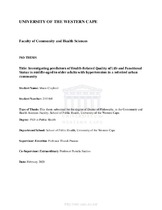| dc.description.abstract | Introduction: In this study, predictors of health-related quality of life and functional status in
people with hypertension were investigated. Hypertension is the leading preventable cause of
premature death.
Aims: The aims of the study were to (1) assess the relationships between socio-demographic
variables, psychosocial variables and disease morbidity with health-related quality of life (HRQoL)
and functional status (FS) outcome variables, and (2) develop multivariate predictive
models to predict H-RQoL (social, psychological, physical and environmental) and FS physical
component summary (PCS) and mental component summary (MCS) outcomes.
Methods: A sample of 173 hypertensive participants was subjected to self-administered
questionnaires to assess their levels of H-RQoL and FS. Secondary data, including anthropometric
and blood pressure measurements, disability and chronic disease were used from the South African
Prospective Urban Rural Epidemiology Study, University of the Western Cape. Additional data
were collected using a series of questionnaires, 1.) a personal and demographic questionnaire, 2.)
the World Health Organization Quality of Life – Brief, the Medical Outcomes Survey Short-Form
36 version 2 (SF 36 v2), and 3.) the Proactive Coping Inventory (PCI) questionnaire.
Using systematic data analysis, we assessed (1) relationships between socio-demographic,
psychosocial and disease morbidity variables through correlational analysis (Pearson r, ANOVA),
and (2) the value of socio-demographic, psychosocial and disease morbidity variables in predicting
H-RQoL and FS through multivariate regression analysis yielding six separate regression models.
Results: Findings revealed demographic factors (education, marital status), psychosocial factors
(coping, stress) and disability were significant predictors of H-RQoL and FS. Marital status, home,
work, and financial stress was significantly associated with improved physical, social relationships
and environmental quality of life. Engaging in reflective, strategic, preventive, instrumental,
emotional and avoidance coping had a significant and positive effect on physical quality of life,
but had significant negative effects on social relationships (and environmental quality of life.
Having several disabilities negatively affected the quality of life across all subscales. For FS, the
PCS was significantly associated with age, marital status and employment, and negatively with
strategic, emotional support seeking and avoidance coping. Financial stress, stress at home, and
religious group involvement were significantly associated with the MCS.
Predictors in the psychological QoL model explained 28% of the variance in the model. Having
secondary schooling (p=0.002) and some stress at home (p=0.001) significantly predicted the
psychological quality of life. Not belonging to a religious group (p=0.019) had a positive influence
on social relationships QoL and having moderate financial stress (p=0.028) had a negative impact,
explaining 27% of the variance in the model. Having a college or university education (p=0.039)
and utilising reflective coping (p=0.006) predicted increased physical QoL significantly, whereas
strategic coping predicted decreased physical QoL. Predictors in the physical QoL model
explained 23% of the variance in the model. Possessing a college or university education (p=0.009)
and being unemployed because of illness or old age (p=0.029) significantly predicted increased
environmental QoL. Having several limitations (p=0.002) resulted in five times lower
environmental QoL. The predictors in the model could explain only 19% of the variance in the
model. The final model for the PCS revealed reflective coping (p=0.042) was the only predictor
that increased physical FS. Being currently married (p=0.001), divorced or separated (p=0.013),
having secondary schooling (p=0.003) or college or university education (p=0.004), engaging in
avoidance coping (p=0.043) and having several disabilities (p=0.000) significantly decreased
physical FS, explaining 40% of the variance in the model. In the MCS final model, emotional
coping (p=0.053) increased mental FS. Being currently married (p=0.011), divorced or separated
(p=0.006), having stopped working because of illness (p=0.008), having moderate home stress
(p=0.041) and financial stress (p=0.015) predicted decreased MCS significantly. Predictors in the
MCS model explained 36% of the variance in the model.
Conclusion: Through the use of a theoretical framework, the Wilson-Cleary model of healthrelated
quality of life facilitated a fuller understanding of the several factors impacting H-RQoL
and FS. Therefore, it is recommended that large-scale studies investigate the causal relationship
between these factors. The study highlights the adverse impact of disability and presence of
comorbid diseases on QoL and functional status. The value of the study lies in the fact that
assessing how an individual perceives his or her health is necessary to develop appropriate
treatment strategies which should lead to positive health outcomes. | en_US |

